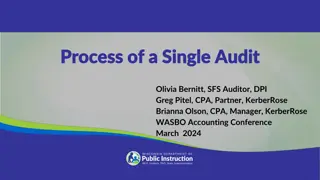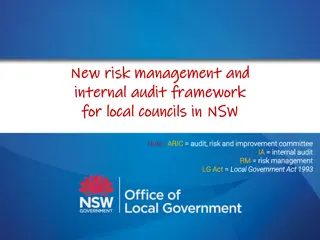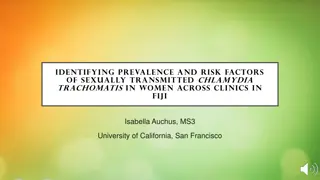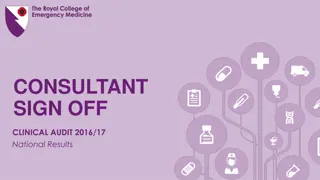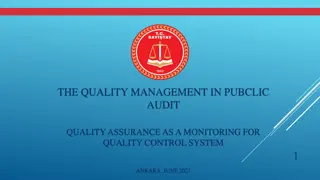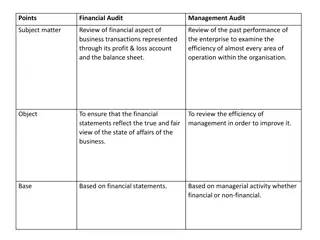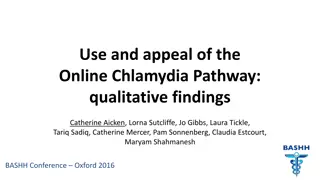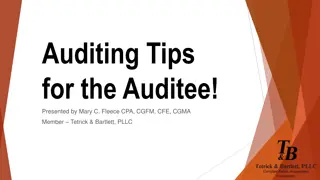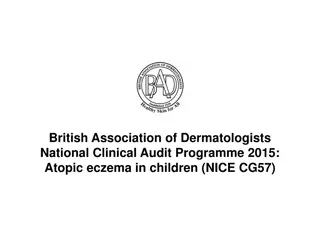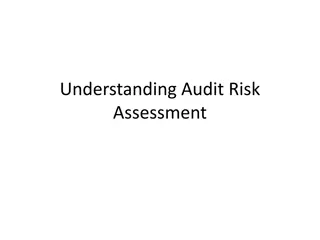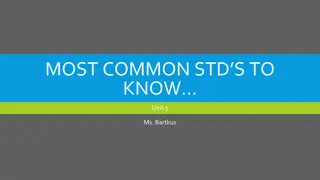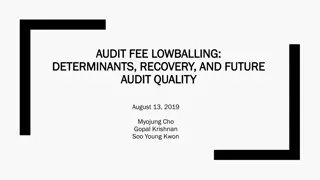Timelines and Standards for Chlamydia Treatment Audit
This audit focused on timelines and standards in chlamydia treatment, highlighting the importance of prompt assessment, testing, and treatment for individuals with STI-related needs. The audit examined various metrics, including time to being seen after contacting sexual health services, CT/NG NAAT results, and time from positive CT result to treatment. It also assessed service accessibility and turn-away rates for walk-in services. The findings provide valuable insights for improving sexual health service delivery.
Download Presentation

Please find below an Image/Link to download the presentation.
The content on the website is provided AS IS for your information and personal use only. It may not be sold, licensed, or shared on other websites without obtaining consent from the author.If you encounter any issues during the download, it is possible that the publisher has removed the file from their server.
You are allowed to download the files provided on this website for personal or commercial use, subject to the condition that they are used lawfully. All files are the property of their respective owners.
The content on the website is provided AS IS for your information and personal use only. It may not be sold, licensed, or shared on other websites without obtaining consent from the author.
E N D
Presentation Transcript
Timelines to be seen, test results and treatment for chlamydia 2019 BASHH National Audit
Relevant standards BASHH/MedFASH Standards for the Management of Sexual Health Services 2014: People with STI-related needs offered to be seen or assessed within 2 working days (WD) of first contacting the service (98%) People with STI-related needs seen or assessed within 2 WD of first contacting the service (80%) Lab reports (or preliminary) within 5 WD (2019 standards: 4 WD) of specimen receipt (97%) People having STI tests who can access results within 10 WD (2019 standards: 8 WD) (95%) 2019 Standards (post-audit): Treatment within 3 weeks (85%) BASHH 2018 Hot six key metrics/criteria for sexual health services: Turn-away rate from walk-in services
Objectives and method To audit: Time to being seen after contacting sexual health service Time to CT/NG NAAT results Time from positive CT result to treatment Survey of STI clinics (level 3 and/or 2) Case note review of individuals with chlamydia but not gonorrhoea or syphilis
Site survey 221 sites responded: 42 (19.0%) were CaSH sites offering level 2 STI services only The rest were mainly integrated, although some offered CaSH or GUM only clinics on some days Median open hours were 35/week
Mode of access 67.0% (148) offered both appointment and walk- in access 26.2% (58) were appointment-only 6.8% (15) were walk-in only Of 163 sites offering walk-in, 72 (44.2%) said they tried to collect some demographic information about individuals turned away
Hot six: Turn-away rate for walk-ins Distribution of turn-away rates, among sites providing data 103 sites (63.2% of those offering walk-ins) provided data on how many people seeking walk-in access were and were not seen, on the last open day: Turn- away rate 30-40% 8% 20-30% 4% 10-20% 11% 5-10% 11% Average turn-away rate: 6.3% Total turn-aways: 265 0-5% 6% Zero 61% 0% 50% 100% Proportion of sites
According to contract/service spec, what should be turnaround time in working days for CT/NG NAAT Not applicable/answered 10% None specified 32% 14 1% 10 21% 7 12% 5 11% 4 1% 3 11% 2 0% 0% 5% 10% 15% 20% 25% 30% 35% Proportion of sites
Case-note review 6138 individuals with chlamydia but not gonorrhoea or syphilis
Characteristics of audited individuals All: 6138 GUM/level 3: 5288 All: GUM/level 3: 100% Total 100.0% Current gender: Female (including trans) Male (including trans) Non-binary or other Not answered 3115 2544 6 473 2637 2233 6 412 50.7% 41.4% 0.1% 7.7% 49.9% 42.2% 0.1% 7.8% Possible higher priority: With symptoms of STI Attended as STI contact Both Neither 1557 1057 308 3216 1556 1022 283 2427 25.4% 17.2% 5.0% 52.4% 29.4% 19.3% 5.4% 45.9% Possible lower priority: Female, non-emergency LARC as main reason for attendance, no STI symptoms nor contact 195 159 3.2% 3.0%
Initial contact/request for care: data for calculating time to be seen Seen in GUM/level 3 with chlamydia N=5288 1559 89.2 % 4717 patient- initiated 2932 226 215 contacted service to request appt 120 236 SH service contacted patient sought walk- in booked own appt online referred in not stated 78.1% 86 2688 yes 244 no 1303 yes 256 no 140 yes 4131 initial contact date recorded no
Access targets 4717 patient-initiated GUM/level 3 attendances 586 (12.4%) not recorded 4131 (87.6%) date of first contact recorded 48 (1.0%) not reported 4083 (86.6%) time to be seen reported 3609 (76.5%) 2 WD Access outcome (target 80%): (target 98%): 474 (10.1%) 3 or more WD Offer outcome 166 (3.5%) could have been 2 WD 112 (2.4%) could not have been 2 WD 196 (4.2%) not reported 76.5% hit 10.1% missed 13.4% unknown 17.6% unknown 80.0% hit 2.4% missed
Cumulative time in working days to be seen in clinic, from patient-initiated request, excluding cases with missing data 100% 80% Percentage of patients 60% 40% 20% Number of working days 0% 0 1 2 3 4 5 6 7 8 9 10 Sought walk-in 99% 99% 99% 100% 100% 100% 100% 100% 100% 100% 100% Requested/booked appointment 28% 46% 67% 76% 80% 84% 87% 90% 91% 92% 93% Requested/booked appointment - priority 30% 50% 73% 82% 87% 90% 93% 95% 96% 96% 97% Sought walk-in Requested/booked appointment Requested/booked appointment - priority
However Site data: turn-aways when open for walk-ins Case-note data appear incompatible with site data By case-note data, 99% of walk- ins were seen on day of initial contact/attempt Average turn-away rate: 6.3% This doesn t record people who come back after being turned away Access target results may not be reliable
Place of sampling for CT/NG NAAT Number % GUM/integrated level 3 clinic: *Of these, already tested positive when first seen 4551 59 74.1 1.0 Tested in GUM and not already positive 4492 73.2 Other sexual health clinic (level 2) 723 11.8 Self-test (eg requested online) 451 7.3 Different clinic setting, eg GP 242 3.9 Outreach or other non-clinical setting 112 1.8 Not known/answered 60 1.0 *Based on subsequent question about time to clinician review of test result
Time to test results 4492 individuals had initial CT/NG NAAT sample taken in GUM/integrated level 3 clinic: 74.1% (3327) clinician reviewed result within 5 WD 24.3% (1091) clinician reviewed result later than 5 WD 1.6% (74) not recorded or not reported
Patient access to test results 4492 individuals had initial CT/NG NAAT sample taken in GUM clinic: 71.0% (3190) attempt made to inform patient within 10 WD 3.1% (138) first attempt to inform patient later than 10 WD 25.9% (1164) not recorded or not reported
Time to treatment 5288 (100%) seen in GUM/level 3 with chlamydia 2.9% 1.9% 95.2% 154 elsewhere (inc bought) 99 not treated/ unclear 5035 treated in service 79.0% 10.8% 5.5% 4177 within 15 WD 569 not stated 289 not within 15 WD 3.7% 1.8% 196 could have been sooner 93 could not/not stated
Results compared with standards Best case scenario Worst case scenario Standard Limited to: Offered to be seen/assessed within 2 WD (98%) Patient-initiated GUM/ level 3 attenders 97.6% 80.0% Seen within 2 WD (80%) As above 89.9% 76.5% Lab report within 5 WD (97%): audited as clinician review Initial CT/NG NAAT sample taken in GUM/level 3 clinic 75.7% 74.1% Patient access to result within 10 WD (95%): audited as attempt to inform As above 96.9% 71.0% Treatment within 3 weeks (2019 standards: 85%) GUM/level 3 attenders 92.8% 79.0%
Limitations Incomplete recording and reporting of data, eg dates/timelines for: First contact/attempt to access service Clinician review of lab report First attempt to inform patient of result Pathway issues: Attendances not initiated by patient More than one clinic attended per episode Attendances/treatment not at first opportunity eg regular attenders who book ahead Decisions to treat prior to positive test result Increasing complexity of service models which cases to include? Timelines are hard to audit!
Recommendations Include lab turn-around in SLA/contract, and monitor locally Ask and record when attenders first made contact/attempted to be seen, and monitor access If access standards not met, assess groups turned away Examine data and discuss any issues in regional meetings and with commissioners
Acknowledgements Thanks to all clinicians who participated Planning group: L Anderson, N Fitzgerald, L Goodall, V McNamara, A Menon-Johansson, H Wiggins Other National Audit Group members: V Apea, S Brady, E Buitendam, L Bull, C Cunningham, L Cunningham, S Davies, S Estreich, A Hughes, H Iveson, E McCarty, H McClean, N Pal, K Perez, H Price, D Raha, C Saing, J Saunders, A Sullivan (chair), M Symonds, S Tayal, H Wallace, H Ward, A Williams





